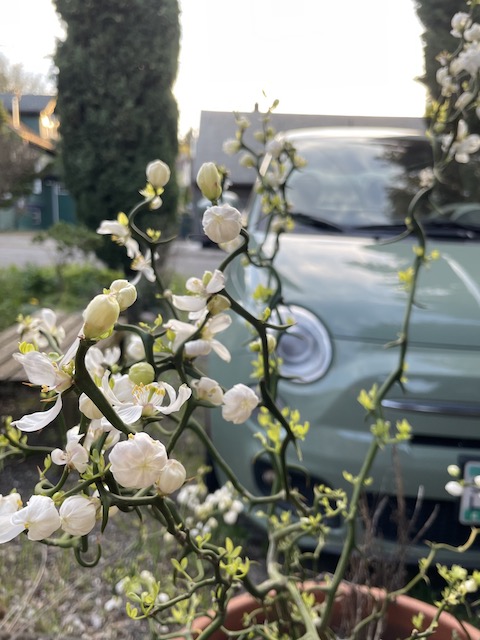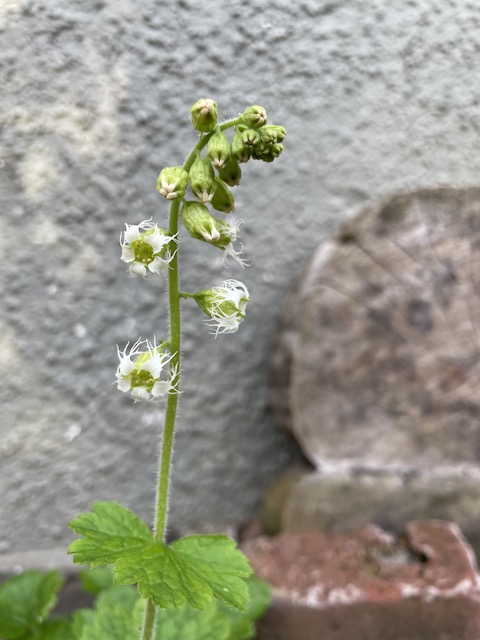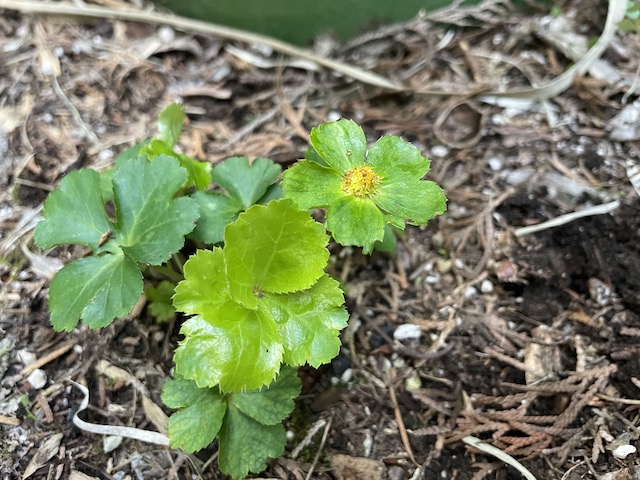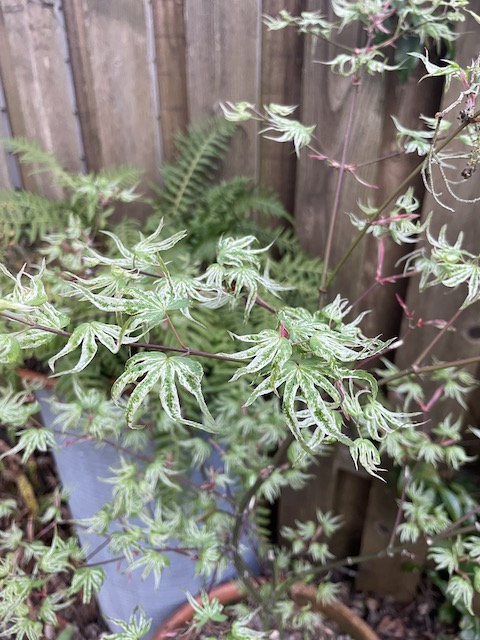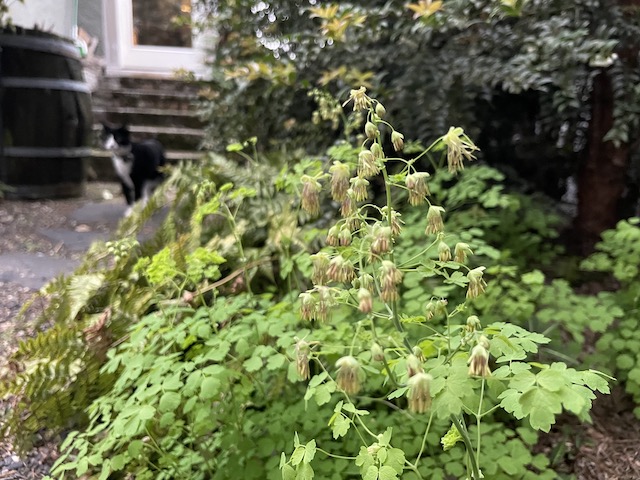Seems a bit late to be posting this, but I needed to wrap up my community college course and just completed my final last week so yay! Now it’s back to more regular posts again. It’s not easy to go to school while working nearly full-time! I salute those of you out there who’ve done so. I had so many hard-working friends at PSU while I was completing my undergraduate degree. Y’all just amaze me.
Last month was kind of “meh” in the garden. I realize now that in my love of heat and the summertime, I’ve kind of ignored spring plantings, so will be adding a few more for next year.
One: This year the large terracotta container of Citrus trifoliata ‘Flying Dragon’ (syn. Poncirus trifoliata ‘Flying Dragon’) bloomed well. Am hoping I’ll have a crop of sweet smelling fruits later this year. While I’ve grown a few citrus plants over the years, I prefer to see them growing other places—since I don’t grow them well. My friend Alex used to have a greenhouse, and he grew the plants more easily. While I do have an outbuilding, I really do hate moving things in an out of it during the winter.
I’m blathering on about all of this because I lost a few citrus plants I’d inherited over the years this past winter. I really need a greenhouse, but do not have the space. THIS ONE THOUGH, it’s hardy, and it bloomed its head off after it had snow dumped on it. It looked at this last winter—and laughed—in flowers.
Slay on flying dragon, slay on!
Two: The Tellima grandiflora I have here is a nice collection given to me by my botanist friend. It came from Pacific County in Washington State and is very fragrant. The plan is to keep growing it, and to collect its seeds to grow more. Fringecups are a wonderful addition to any PNW garden if you’re looking for an easy native plant for damp and shady situations. I may have added this one to a warm and dry spot in order to push it a bit, but I was also hoping to add a shade-making companion plant to the area soon to help it along.
Three: There’s not a lot to say about the Sanicula epipactis (syn. Hacquetia epipactis) other than I fell for the attractive green flowers at some point, and that when I see it in bloom, I smile. Now that the flower has faded, I’m less pleased with it, but it’s not so bad as to make me desirous of its removal. In my garden, it’s grown well so far.
Four: Unlike many of my close friends and gardening community companions I have a lot of Japanese maples. Acer palmatum ‘Ukigumo’ is by far my favorite. It’s name means drifting of floating clouds and you can maybe see how it could have that look to it.
This to me is a special tree so when I cut down the old apple tree that was part of the original garden plan, I was happy to add this to another side of the back garden.
While it does cost a bit, I highly recommend considering the purchase of one of these.
Five: Alyssum montanum never disappoints in the springtime. This low growing plant in the Brassicaceae family has been blooming in this difficult spot reliably for YEARS.
I think it’s time to divide this clump, and spread it around a bit more in my pride strip aka hellstrip. June is just around the corner and this is part of how I show my support for Pride Month.
Six: Oregon gold thread (Coptis laciniata) is a native plant that gets its common name from the color of its beautiful roots. This is not a plant seen often in cultivation, so if you see it in a nursery, and you have the right spot for it, I suggest you pick it up. Luckily, we were selling some at Secret Garden Growers last year so I gleefully grabbed this one and it’s done WELL in my garden since it was planted. It’s even started to spread a tiny bit. It needs regular moisture and shade, but once established, it will settle in nicely.
Seven: Adorable little woodland blooms don’t feel like me, but well, here we are and it’s the blue of these flowers, set inside of the white, that just sets my heart aflutter. Omphalodes cappavocica ‘Starry Eyes’ is an easy-to-grow perennial and I’ve had it for at least a decade in my garden. The patch seen here is in full shade, and it’s often dry in that spot—but not completely.
Eight: What’s not to like about this Luzula sylvatica now that its grown into this lovely little mop on the ground? I think I picked this one up at Xera Plants and had no idea where it would go until I plopped it down here at some point. I don’t think I had expectations at all, and whatever I had been thinking, this plant has far exceeded those expectations. In this spot in the dry shade this grass has done great. It looks great year round too because it’s in a protected area of the garden.
Nine: Not sure why I have so many native plants in this post, but I do believe that gardens should have as many native plants included as is possible both for a kind of continuity with the surrounding setting, as well as the fact that other living creatures native to this region appreciate having them here in order to survive in one way or another. Besides, I want to remind myself that I’m NOT in control of nature and letting plants go a bit wild has always mattered to me.
The artificiality of perfection in the formal garden, or being told that someone has a “foreign” English garden makes me feel the same as if they’ve said they’ve planted an invasive species. The colonial mindset continues I guess and I’m more than happy to have both my interior cultural projection of my own European heritage, mixed in with a native plant garden with plants representing the region I grew up in and love dearly—to my core.
Mahonia aquifolium is yet one of the native beacon native plants for me. I have two at my house, and I love them throughout the seasons. They’re sited at the “nerve center” of my garden, the heart of it, where I work the most.
They’re also our state flower, and can handle basically any conditions. Mine are both on the southside of the house, they’re not watered a lot, and both get a lot of sun. I love them, they remind me of home, so home is where they’re planted.
Ten: Lastly, our native Thalictrum occidentale is a fun plant with a wide native range. From Alaska to Northern California to Colorado and Wyoming, this plant needs a shady spot with some regular moisture. For me, in my garden, it has spread a bit. I wish I could give it more space. It it an aggressive grower, but it is NOT a thug. Also, at some point, it will all but disappear in my garden as we heat up during the summer. Deciduous perennials will do this. If it was damper and cooler it would likely stick around a bit longer. So by the time I’m tired of it, it’s cooled it heels. So when it returns the next year, I’m always happy to see it again like a friend returning to visit.
It is dioecious, and the male flowers are the showy ones. They have a bit of the wiggle effect on those male flowers. They make me giggle and I have a dirty mind, so I see them as itty bitty tata tassels. Just have to be free to be me sometimes I guess.
So that took a bit longer to complete than I’d wanted it too. You’ll have an update soon on how I feel about the garden THIS month.
I also wanted to mention this podcast I was recently interviewed for and how much fun it was to participate in so be sure to give it a listen and check out the other guests as well. https://meristemhorticulture.com/the-plantastic-podcast/17-ann-amato-seedstress-of-the-pacific-northwest

